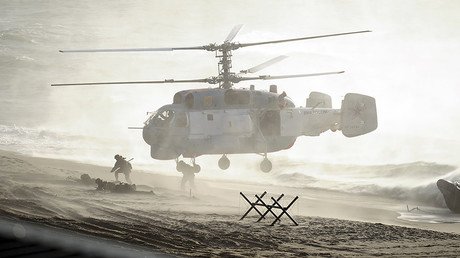US brings tanks & other hardware to Poland for 'counter-Russia' operation (VIDEO)

US tanks, combat vehicles and other military equipment have arrived in the Polish city of Gdansk as part of Operation Atlantic Resolve, a NATO exercise aimed at boosting the alliance's military presence in Eastern Europe.
The equipment arriving to the port city on Wednesday, from the 2nd Armored Brigade Combat Team, 1st Infantry Division, has been filmed by Ruptly.
It was deployed as part of Operation Atlantic Resolve, which is aimed at boosting NATO's military presence in Estonia, Latvia, Lithuania, Poland, Romania, Bulgaria and Hungary.
The operation was launched in April 2014 following the reunification of the Crimean Republic with Russia following a referendum, which the US and other Western countries refer to as an “annexation.”
Washington sees the operation as a demonstration of US commitment to Europe's security amid so-called Russian aggression in the region.
“Atlantic Resolve demonstrates the US commitment to the security of NATO allies on air, land and at sea. To ensure its own security, NATO must have strong, committed and capable allies, which is why the United States has fought, exercised and trained with our European allies for the past 70 years,” a statement on US Army Europe's website reads.
Meanwhile, Russia has repeatedly criticized the buildup of NATO forces close to its borders, as well as the military bloc fortifying naval positions in the Black Sea, saying the actions increase the risk of incidents and poses a threat to Russian national security.
Still, the NATO drills continue to take place on Russia's doorstep, including a large-scale Black Sea exercise in Ukraine in July, which involved British and Turkish military vessels. Those drills followed the massive 'Sea Breeze' war games in the same area.
In June, 5,300 troops from 10 NATO countries took part in the ‘Iron Wolf’ military drills in Lithuania, aiming to counter the “Russian threat.” Part of the drills took place on a patch of land in the Suwalki Gap, which borders the Russian exclave of Kaliningrad.
The equipment deployment comes just two days after Sweden launched its biggest military drills in 23 years, with several NATO countries also taking part. Sweden is not a member of NATO, but membership is expected to be a contentious issue in the 2018 election.
In a July statement, the Swedish Armed Forces wrote that “several other countries” had been invited to take part in the exercise to enhance “Sweden's defense capability against a larger, sophisticated opponent,” in what appeared to be a reference to Russia.
Despite NATO countries taking part in the massive Swedish drills – some of which are again taking place near Kaliningrad – the alliance has no problem slamming Russia for conducting a much smaller exercise with Belarus.
Russia and Belarus are set to launch their own Zapad war games on Thursday, which will involve up to 12,700 troops, 70 aircraft, and nearly 700 land vehicles.
The head of NATO accused Russia earlier this month of blocking the alliance from properly observing the exercise, saying that an offer for three of its experts to observe the drill fell short of the Kremlin's international obligations under the Vienna document on military exercise transparency.
However, Russia has stressed that only 12,700 troops are taking part in the war games, which falls under the 13,000 threshold for mandatory monitoring under the Vienna agreement.
NATO, however, believes – without evidence – that more troops will be involved.
Estonian Prime Minister Jüri Ratas inflated the numbers to as many as 100,000 Russian soldiers, supposedly to be mobilized during the exercise – a belief which has also been voiced by German Defense Minister Ursula von der Leyen.
In line with the ‘Russian aggression’ narrative, NATO has also voiced suspicion that the war games could be used to move forces and equipment closer to NATO's eastern flank – an accusation which both Russia and Belarus have denied.
Russia maintains that despite Western and NATO criticism, the Zapad drills are purely defensive in nature and will help practice for dealing with a terrorist threat in the future.















